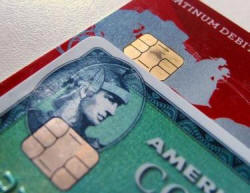|
 Chip
cards scarce in U.S., despite deadlines: study Chip
cards scarce in U.S., despite deadlines: study
 Send a link to a friend
Send a link to a friend
[September 30, 2015]
By Beth Pinsker
NEW YORK (Reuters) - The U.S. credit card
industry and merchants face a deadline on Thursday to make progress with
the transition to cards with chip technology, but less than half of
consumers have the new cards in their wallets.
|
|
 A new study from CreditCards.com found that only 40 percent of
cardholders have chip cards, which employ an extra level of security
above the traditional magnetic stripe to prevent fraud. A new study from CreditCards.com found that only 40 percent of
cardholders have chip cards, which employ an extra level of security
above the traditional magnetic stripe to prevent fraud.
Known as EMV technology, the chips in the cards - which can work in
conjunction with PIN codes - help prevent thieves from making
copycat cards. Consumers dip the cards instead of swiping them, and
then follow keypad instructions. Other areas of the world,
particularly Europe, have already widely adopted the technology.
This week's deadline was not about getting cards into the hands of
consumers, but rather about a liability shift between credit card
issuers and merchants. In fact, there is no firm deadline by which
all consumers are supposed to get cards.
"We were expecting a little bigger number, but we also understood
that this is going to be a long process," says Matt Schulz, senior
industry analyst at CreditCards.com.

MasterCard reported this week that 40 percent of all U.S.-branded
consumer credit cards are chip cards. A quarter of U.S. merchants
have already transitioned to accept these cards, according to a
MasterCard press release. For stores that have not, the chip cards
can still be swiped the old-fashioned way.
Right now, you are most likely to see a chip payment station at a
major national retailer like Target or Home Depot <HD.N, Schulz
said. Small merchants are likely to lag behind for years.
GET YOUR CARD
The CreditCard.com study also found that those with annual income
over $75,000 are more than twice as likely to have a chip card than
people with lower incomes.
That is because the earliest adopters of chip cards are frequent
international travelers, according to Schulz.
[to top of second column] |

That transition to a broader group of consumers is just going to
take time, he said, because card issuers are drawing it out due to
the expense of replacing cards.
For consumers impatient to get a chip card, they can call and
request one from their issuer, or seek more information on the
industry's explanation website (http://gochipcard.com/). The
Consumer Financial Protection Bureau also has information and can
take complaints for consumers having issues (http://www.consumerfinance.gov/).
Otherwise, consumers are likely to just get a new card in the mail
seemingly at random - driven by a renewal date or by high-profile
deadlines like the one this week.
"It's not a coincidence to get a card around this time," said
Carolyn Balfany, senior vice president, U.S. product delivery for
MasterCard Worldwide.
The change consumers will likely notice most is that more and more
stores will turn on their terminals as of Thursday. But do not
expect too many problems, said Balfany: "It's not Y2K."
(Editing by Lauren Young and Cynthia Osterman)
[© 2015 Thomson Reuters. All rights
reserved.] Copyright 2015 Reuters. All rights reserved. This material may not be published,
broadcast, rewritten or redistributed.

 |